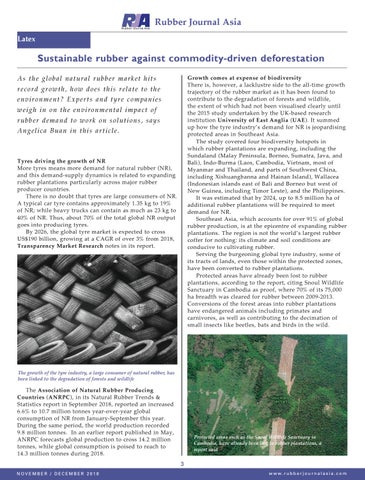Rubber Journal Asia Latex
Sustainable rubber against commodity-driven deforestation As the global natural rubber market hits
Growth comes at expense of biodiversity There is, however, a lacklustre side to the all-time growth trajectory of the rubber market as it has been found to contribute to the degradation of forests and wildlife, the extent of which had not been visualised clearly until the 2015 study undertaken by the UK-based research institution University of East Anglia (UAE). It summed up how the tyre industry’s demand for NR is jeopardising protected areas in Southeast Asia. The study covered four biodiversity hotspots in which rubber plantations are expanding, including the Sundaland (Malay Peninsula, Borneo, Sumatra, Java, and Bali), Indo-Burma (Laos, Cambodia, Vietnam, most of Myanmar and Thailand, and parts of Southwest China, including Xishuangbanna and Hainan Island), Wallacea (Indonesian islands east of Bali and Borneo but west of New Guinea, including Timor Leste), and the Philippines. It was estimated that by 2024, up to 8.5 million ha of additional rubber plantations will be required to meet demand for NR. Southeast Asia, which accounts for over 91% of global rubber production, is at the epicentre of expanding rubber plantations. The region is not the world’s largest rubber coffer for nothing: its climate and soil conditions are conducive to cultivating rubber. Serving the burgeoning global tyre industry, some of its tracts of lands, even those within the protected zones, have been converted to rubber plantations. Protected areas have already been lost to rubber plantations, according to the report, citing Snoul Wildlife Sanctuary in Cambodia as proof, where 70% of its 75,000 ha breadth was cleared for rubber between 2009-2013. Conversions of the forest areas into rubber plantations have endangered animals including primates and carnivores, as well as contributing to the decimation of small insects like beetles, bats and birds in the wild.
record growth, how does this relate to the
environment? Experts and tyre companies weigh in on the environmental impact of
rubber demand to work on solutions, says Angelica Buan in this article.
Tyres driving the growth of NR More tyres means more demand for natural rubber (NR), and this demand-supply dynamics is related to expanding rubber plantations particularly across major rubber producer countries. There is no doubt that tyres are large consumers of NR. A typical car tyre contains approximately 1.35 kg to 19% of NR; while heavy trucks can contain as much as 23 kg to 40% of NR. Thus, about 70% of the total global NR output goes into producing tyres. By 2026, the global tyre market is expected to cross US$190 billion, growing at a CAGR of over 3% from 2018, Transparency Market Research notes in its report.
The growth of the tyre industry, a large consumer of natural rubber, has been linked to the degradation of forests and wildlife
The Association of Natural Rubber Producing Countries (ANRPC), in its Natural Rubber Trends & Statistics report in September 2018, reported an increased 6.6% to 10.7 million tonnes year-over-year global consumption of NR from January-September this year. During the same period, the world production recorded 9.8 million tonnes. In an earlier report published in May, ANRPC forecasts global production to cross 14.2 million tonnes, while global consumption is poised to reach to 14.3 million tonnes during 2018.
Protected areas such as the Snoul Wildlife Sanctuary in Cambodia, have already been lost to rubber plantations, a report said
3 NOVEMBER / DECEMBER 2018
w w w. r u b b e r j o u r n a l a s i a . c o m
